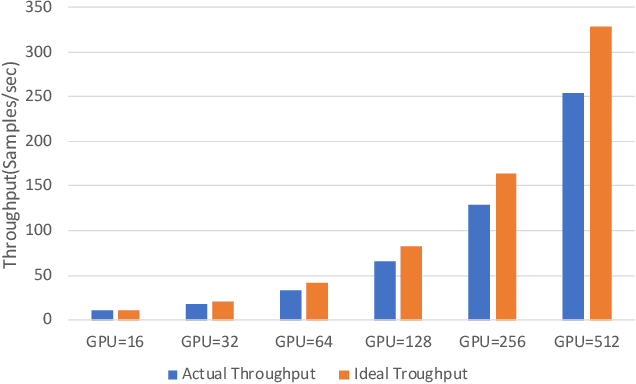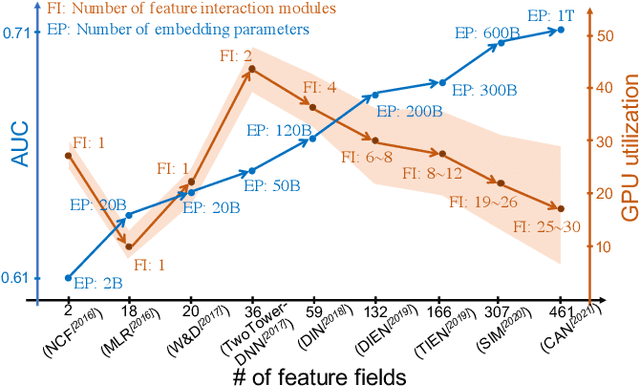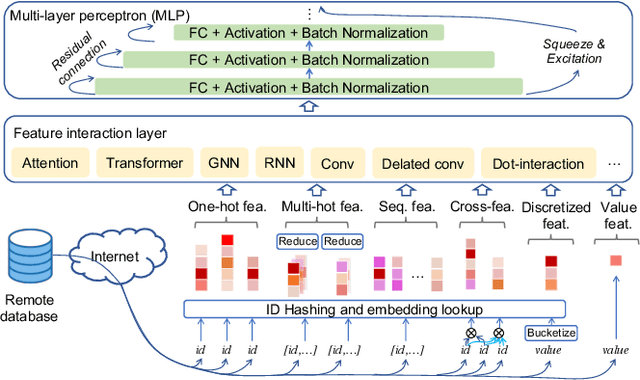Jianbo Dong
Boosting Large-scale Parallel Training Efficiency with C4: A Communication-Driven Approach
Jun 07, 2024



Abstract:The emergence of Large Language Models (LLMs) has necessitated the adoption of parallel training techniques, involving the deployment of thousands of GPUs to train a single model. Unfortunately, we have found that the efficiency of current parallel training is often suboptimal, largely due to the following two main issues. Firstly, hardware failures are inevitable, leading to interruptions in the training tasks. The inability to quickly identify the faulty components results in a substantial waste of GPU resources. Secondly, since GPUs must wait for parameter synchronization to complete before proceeding to the next round of computation, network congestions can greatly increase the waiting time for GPUs. To address these challenges, this paper introduces a communication-driven solution, namely the C4. The key insights of C4 are two folds. First, in parallel training, collective communication exhibits periodic and homogeneous characteristics, so any anomalies are certainly due to some form of hardware malfunction. By leveraging this feature, C4 can rapidly identify the faulty components, swiftly isolate the anomaly, and restart the task, thereby avoiding resource wastage caused by delays in anomaly detection. Second, the predictable communication model of collective communication, involving few large flows, allows C4 to efficiently execute traffic planning, substantially reducing network congestion. C4 has been extensively implemented across our production systems, cutting error-induced overhead by roughly 30% and enhancing runtime performance by about 15% for certain applications with moderate communication costs.
SPACE-2: Tree-Structured Semi-Supervised Contrastive Pre-training for Task-Oriented Dialog Understanding
Sep 14, 2022



Abstract:Pre-training methods with contrastive learning objectives have shown remarkable success in dialog understanding tasks. However, current contrastive learning solely considers the self-augmented dialog samples as positive samples and treats all other dialog samples as negative ones, which enforces dissimilar representations even for dialogs that are semantically related. In this paper, we propose SPACE-2, a tree-structured pre-trained conversation model, which learns dialog representations from limited labeled dialogs and large-scale unlabeled dialog corpora via semi-supervised contrastive pre-training. Concretely, we first define a general semantic tree structure (STS) to unify the inconsistent annotation schema across different dialog datasets, so that the rich structural information stored in all labeled data can be exploited. Then we propose a novel multi-view score function to increase the relevance of all possible dialogs that share similar STSs and only push away other completely different dialogs during supervised contrastive pre-training. To fully exploit unlabeled dialogs, a basic self-supervised contrastive loss is also added to refine the learned representations. Experiments show that our method can achieve new state-of-the-art results on the DialoGLUE benchmark consisting of seven datasets and four popular dialog understanding tasks. For reproducibility, we release the code and data at https://github.com/AlibabaResearch/DAMO-ConvAI/tree/main/space-2.
PICASSO: Unleashing the Potential of GPU-centric Training for Wide-and-deep Recommender Systems
Apr 17, 2022



Abstract:The development of personalized recommendation has significantly improved the accuracy of information matching and the revenue of e-commerce platforms. Recently, it has 2 trends: 1) recommender systems must be trained timely to cope with ever-growing new products and ever-changing user interests from online marketing and social network; 2) SOTA recommendation models introduce DNN modules to improve prediction accuracy. Traditional CPU-based recommender systems cannot meet these two trends, and GPU- centric training has become a trending approach. However, we observe that GPU devices in training recommender systems are underutilized, and they cannot attain an expected throughput improvement as what it has achieved in CV and NLP areas. This issue can be explained by two characteristics of these recommendation models: First, they contain up to a thousand input feature fields, introducing fragmentary and memory-intensive operations; Second, the multiple constituent feature interaction submodules introduce substantial small-sized compute kernels. To remove this roadblock to the development of recommender systems, we propose a novel framework named PICASSO to accelerate the training of recommendation models on commodity hardware. Specifically, we conduct a systematic analysis to reveal the bottlenecks encountered in training recommendation models. We leverage the model structure and data distribution to unleash the potential of hardware through our packing, interleaving, and caching optimization. Experiments show that PICASSO increases the hardware utilization by an order of magnitude on the basis of SOTA baselines and brings up to 6x throughput improvement for a variety of industrial recommendation models. Using the same hardware budget in production, PICASSO on average shortens the walltime of daily training tasks by 7 hours, significantly reducing the delay of continuous delivery.
 Add to Chrome
Add to Chrome Add to Firefox
Add to Firefox Add to Edge
Add to Edge